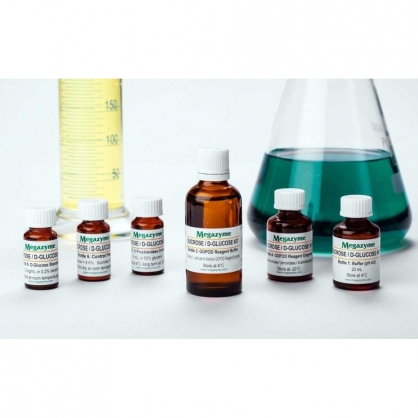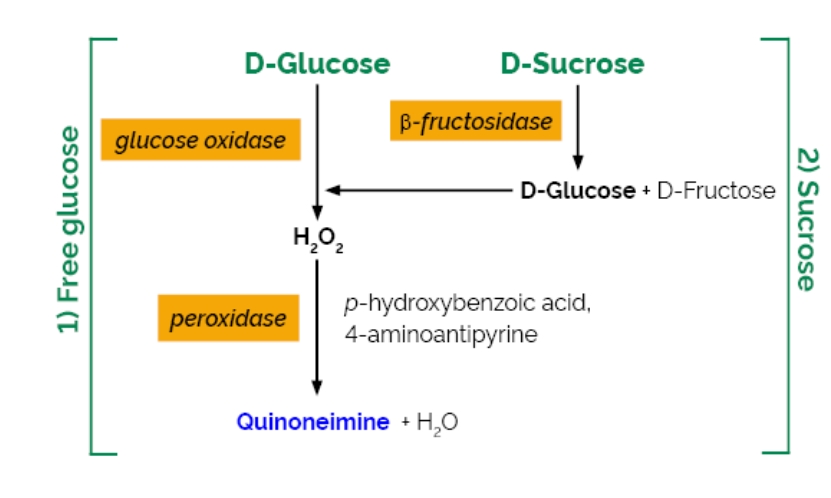- 操作流程(ASSAY PROCEDURE)
Assay for Glucose and Sucrose:
1. Add 0.2 mL of sample extract (containing D-glucose + sucrose at a concentration of 0.02-0.5 mg/mL) to the bottom of four 16 x 100 mm glass test tubes. Add either solution 1 (diluted buffer) or solution 2 (diluted β-fructosidase) to duplicate tubes as follows:
➡️- 0.2 mL of sample + 0.2 mL solution 1 [D-Glucose] … This is ‘A’
➡️- 0.2 mL of sample + 0.2 mL solution 2 [Sucrose + D-Glucose] …..This is ‘B’
2. Incubate all tubes, including the reagent Blanks and D-glucose controls at 50°C for 20 min. 3. Add 3.0 mL of GOPOD Reagent to all tubes and incubate these at 50°C for 20 min.
3. Add 3.0 mL of GOPOD Reagent to all tubes and incubate these at 50°C for 20 min.
4. Measure all absorbances at 510 nm against the reagent blank.
Absorbances:
∆A = GOPOD absorbance for A
∆B = GOPOD absorbance for B
- 樣品稀釋 (SAMPLE DILUTION)
The amount of sucrose and D-glucose present in the cuvette should range between 10 μg and 100 μg. The sample solution must therefore be diluted sufficiently to yield a sugar concentration between 0.02 and 0.5 g/L.

- 樣品準備 (SAMPLE PREPARATION)
NOTE: Samples containing high amounts of protein or fats may cause interference in target analyte determination and require sample clarification prior to analysis using Carrez Clarification. Carrez Clarification can be simplified using the Megazyme brand Carrez Clarification kit (K-CARREZ) available from Neogen. The supplied K-CARREZ reagents should be diluted prior to use as described on page 2 of the K-CARREZ assay protocol and the assay procedure for clarification followed as described on page 3. The clarified sample solution prepared using the K-CARREZ kit should then be analysed for D-glucose/Sucrose content as described in the assay procedure.
1. Liquid foodstuffs.
Use clear, colourless or slightly coloured solutions directly or after dilution according to the dilution table. Filter turbid solutions (Whatman GF/C glass fibre filter papers) or clarify using the Carrez Clarification kit (K-CARREZ). Strongly coloured solutions which are used undiluted for the assay because of their low sucrose and D-glucose concentrations must be decolourised with polyvinylpolypyrrolidone (PVPP). Beverages containing gas should be degassed under vacuum.
2. Solid foodstuffs.
Solid samples (such as cereals and flours) should be homogenised using a 0.5 mm screen. Weigh out a representative sample weight (e.g., 1 g) and add to a 100 mL volumetric flask and make to the mark (i.e. 100 mL) with distilled water. Stir vigorously until the sample is fully dispersed or dissolved, heat to 60 °C if necessary. Filter and use the clear solution, diluted further (if required) for the assay. The weights and volumes used here are provided as a guide only and may need to be altered depending on the sample being tested. If you require further assistance with sample preparation, or information on validated matrices please contact your Neogen representative.
商品特色
商品規格
- 商品規格(250個檢測反應)
Bottle 1:
Buffer (20 mL, pH 4.6).
Store at 4°C. See individual label for expiry date.
Bottle 2:
β-Fructosidase (invertase) solution (yeast; 5 mL) plus sodium azide as a preservative (0.02% w/v).
Store at 4°C. See individual label for expiry date.
Bottle 3:
GOPOD Reagent Buffer (50 mL, pH 7.4),
p-hydroxybenzoic acid and sodium azide (0.09% w/v).
Store at 4°C. See individual label for expiry date.
Bottle 4:
GOPOD Reagent Enzymes.
Glucose oxidase plus peroxidase and 4-aminoantipyrine.
Freeze-dried powder.
Store below -10°C. See individual label for expiry date.
Bottle 5:
D-Glucose standard solution (5 mL, 1.0 mg/mL) in 0.2% (w/v) benzoic acid.
Store sealed at room temperature. See individual label for expiry date.
Bottle 6:
Control flour sample. Sucrose and D-glucose contents shown on vial label.
Store sealed at room temperature. See individual label for expiry date.



